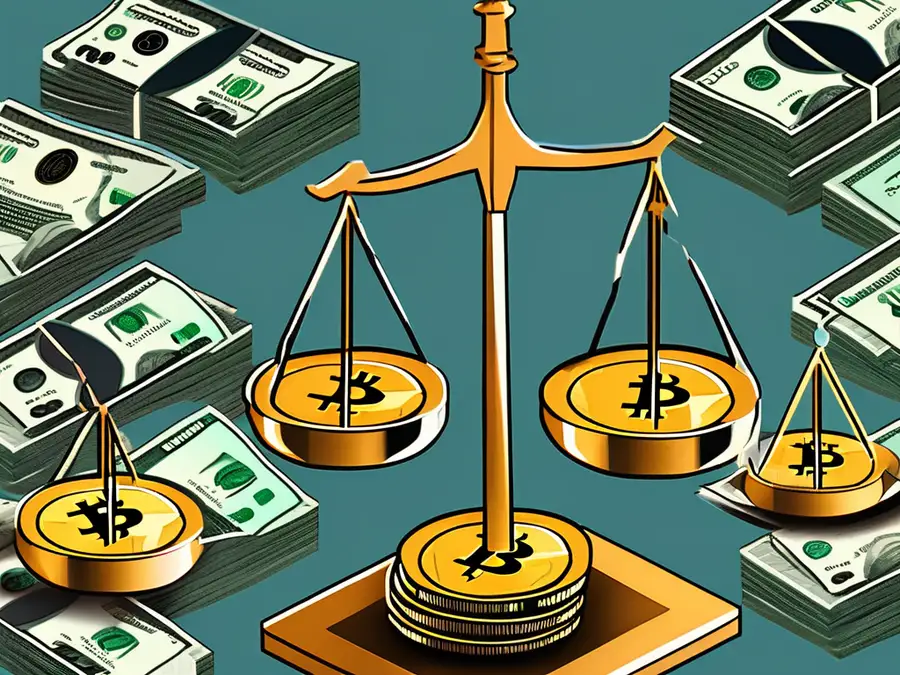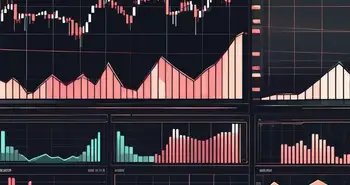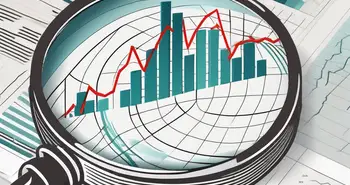Crypto Funding Rates Explained: How They Impact Your Trading Profits

Are you interested in delving into the world of cryptocurrency trading? If so, understanding crypto funding rates is crucial to your success. In this comprehensive guide, I will walk you through everything you need to know about crypto funding rates, including what they are, how they work, the factors that influence them, the different types available, and even how to calculate them. So, let's get started!
What are Crypto Funding Rates?
Crypto funding rates are essentially the interest rates that traders pay or receive on their leveraged positions in cryptocurrency trading. These rates are used in perpetual futures contracts, which are derivative contracts that allow traders to take leveraged positions without an expiration date.
The Basics of Crypto Funding Rates
In simplest terms, when you trade cryptocurrency with leverage, you essentially borrow funds from the trading platform or other traders to magnify your trading position. Crypto funding rates are the fees you pay or receive for borrowing or lending those funds. These rates are typically calculated and settled every 8 hours.
It's important to note that crypto funding rates can vary across different trading platforms and are influenced by factors such as market demand, liquidity, and the overall sentiment of traders in the market. Traders need to stay informed about these rates to make informed decisions about their leveraged positions.
Importance of Crypto Funding Rates in Trading
Understanding crypto funding rates is essential because they directly impact your trading costs and potential profits. High funding rates can increase your borrowing costs, making it less profitable to hold leveraged positions for an extended period. Conversely, low or negative funding rates can provide an opportunity to earn additional income on your leveraged positions.
Traders often monitor funding rates closely to gauge market sentiment and potential price movements. A sudden increase in funding rates may indicate a higher demand for long positions, while a decrease could signal a shift towards short positions. By analyzing these rates in conjunction with other market indicators, traders can develop more effective trading strategies.
How Crypto Funding Rates Work
Now that you have a basic understanding of what crypto funding rates are, let's explore how they work in practice.
Crypto funding rates play a crucial role in the world of cryptocurrency trading, influencing the costs and benefits associated with leveraging positions. These rates are essentially the mechanism by which traders on platforms like BitMEX, Binance, and others are incentivized to either hold or open positions based on market demand. Understanding how these rates are calculated and applied can give traders a competitive edge in the volatile world of crypto trading.
The Role of Lenders and Borrowers
In the world of crypto funding rates, there are two main parties involved: lenders and borrowers. Lenders are traders who provide the funds that borrowers need to leverage their positions. These lenders earn interest on their funds, while borrowers pay interest for the funds they borrow.
Lenders play a critical role in providing liquidity to the market, allowing traders to access additional capital to amplify their trading strategies. By lending out their assets, lenders can earn passive income through interest payments, making their crypto holdings work for them even when they are not actively trading.
Understanding Long and Short Positions
To fully comprehend crypto funding rates, it's important to understand long and short positions. In a long position, a trader buys an asset with the expectation that its value will rise. In contrast, a short position involves selling an asset with the expectation that its value will decrease. Crypto funding rates vary depending on whether a trader is in a long or short position.
Traders strategically choose between long and short positions based on market conditions and their predictions for price movements. By understanding how funding rates impact these positions, traders can optimize their trading strategies to maximize profits and minimize risks in the dynamic world of cryptocurrency trading.
Factors Influencing Crypto Funding Rates
Now that we have covered the basics of crypto funding rates and how they work, let's delve into the key factors influencing these rates.
Understanding the intricate world of crypto funding rates involves exploring various factors that can sway these rates in different directions. While market demand and supply dynamics are crucial, there are other elements at play that can significantly impact the funding rates within the cryptocurrency ecosystem.
Market Demand and Supply
Market demand and supply play a significant role in determining crypto funding rates. When there is a high demand for leveraged positions, the funding rates tend to increase as lenders have more bargaining power. On the other hand, when the demand for leveraged positions decreases, the funding rates tend to decrease as well.
Moreover, the interplay between market participants, including traders, investors, and institutions, can create fluctuations in demand and supply, further influencing funding rates. Factors such as investor sentiment, macroeconomic trends, and regulatory developments can also shape the overall market dynamics, impacting funding rates in the process.
Volatility of Cryptocurrency
The volatility of the cryptocurrency market also affects funding rates. During periods of high volatility, funding rates may increase as lenders perceive higher risks and demand compensation for lending their funds. Conversely, during periods of low volatility, funding rates may decrease.
It is essential for market participants to closely monitor and analyze the volatility trends within the cryptocurrency space to anticipate potential shifts in funding rates. By staying informed about market conditions and understanding the relationship between volatility and funding rates, investors and traders can make more informed decisions regarding their crypto funding strategies.
Different Types of Crypto Funding Rates
Now, let's explore the different types of crypto funding rates available in the market.
When it comes to crypto funding rates, understanding the nuances of each type can significantly impact trading strategies and outcomes. Let's delve deeper into the world of crypto funding rates to gain a comprehensive understanding of how they function within the digital asset ecosystem.
Fixed Funding Rates
Fixed funding rates are predetermined rates agreed upon by lenders and borrowers. These rates remain constant for a specified period, usually 8 hours, before being recalculated. Fixed funding rates provide stability for traders who prefer a predictable borrowing cost.
Traders utilizing fixed funding rates can accurately forecast their borrowing expenses over the agreed-upon period, allowing for better risk management and strategic decision-making. This predictability can be particularly advantageous in volatile market conditions, providing a sense of security amidst price fluctuations.
Variable Funding Rates
Variable funding rates, as the name suggests, fluctuate based on market demand and supply dynamics. These rates can change every 8 hours, offering traders the opportunity to benefit from potentially lower borrowing costs during periods of low demand.
The flexibility of variable funding rates enables traders to adapt to changing market conditions swiftly. By leveraging these rates effectively, traders can optimize their borrowing costs and capitalize on favorable lending opportunities. However, this dynamic nature also introduces an element of uncertainty, requiring traders to stay vigilant and responsive to market shifts.
How to Calculate Crypto Funding Rates
Now that you have a solid understanding of crypto funding rates and their various types, let's demystify how to calculate them.
Understanding the Formula
The formula to calculate crypto funding rates is relatively straightforward. It typically includes variables such as the funding rate, the position value, and the contract's leverage. Most trading platforms provide real-time calculators and tools to simplify this process.
Practical Tips for Calculation
When calculating crypto funding rates, be sure to double-check the inputs, including the position size and leverage. Small errors can lead to significant differences in the calculated rates. Additionally, stay updated with the latest funding rate calculations provided by your trading platform to make informed decisions.
As an experienced trader, I can confidently say that understanding crypto funding rates is vital to successful trading. These rates can significantly impact your overall profitability, so it's essential to stay informed and adapt your strategies accordingly.
Remember, while crypto funding rates can provide opportunities for increased profits, they also come with risks. It's crucial to conduct thorough research and analysis before entering leveraged positions. Don't be afraid to seek guidance from experienced traders or professionals in the field.
FAQ – Frequently Asked Questions
What are crypto funding rates?
Crypto funding rates are interest rates paid or received by traders who engage in leveraged positions using perpetual futures contracts in cryptocurrency trading.
How do crypto funding rates work?
Crypto funding rates work by lenders providing funds to borrowers, who use these funds to leverage their trading positions. Borrowers pay interest, while lenders earn interest on their lent funds.
What factors influence crypto funding rates?
The main factors influencing crypto funding rates are market demand and supply for leveraged positions and the volatility of the cryptocurrency market.
What are the different types of crypto funding rates?
The two main types of crypto funding rates are fixed funding rates, which remain constant for a specified period, and variable funding rates, which fluctuate based on market dynamics.
How can I calculate crypto funding rates?
Crypto funding rates can be calculated using a formula that incorporates variables such as the funding rate, position value, and leverage. Trading platforms often provide calculators and tools for ease of calculation.
Now that you have a thorough understanding of crypto funding rates, you are better equipped to navigate the world of cryptocurrency trading. Remember to stay informed, conduct thorough research, and adapt your strategies based on market conditions. Happy trading!
Ready to apply your newfound knowledge of crypto funding rates in a practical setting? Look no further than Morpher.com, a revolutionary trading platform that leverages blockchain technology to offer a unique and innovative trading experience. With Morpher, you can trade a variety of asset classes, including cryptocurrencies, without any fees or liquidity constraints. Take advantage of fractional investing, short selling, and up to 10x leverage to maximize your trading strategies. Plus, enjoy the safety of a non-custodial wallet and the excitement of trading Virtual Futures. Sign Up and Get Your Free Sign Up Bonus today to transform the way you trade and make the most of the opportunities in the dynamic world of investing.

Disclaimer: All investments involve risk, and the past performance of a security, industry, sector, market, financial product, trading strategy, or individual’s trading does not guarantee future results or returns. Investors are fully responsible for any investment decisions they make. Such decisions should be based solely on an evaluation of their financial circumstances, investment objectives, risk tolerance, and liquidity needs. This post does not constitute investment advice.

Painless trading for everyone
Hundreds of markets all in one place - Apple, Bitcoin, Gold, Watches, NFTs, Sneakers and so much more.

Painless trading for everyone
Hundreds of markets all in one place - Apple, Bitcoin, Gold, Watches, NFTs, Sneakers and so much more.









